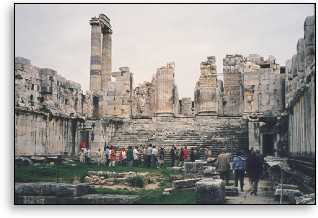Didyma,
Miletus,
Kusadasi
Western Turkey - Personal Journal
Day
14 - Tuesday, 14 April 1998
Leaving Pammukale on Tuesday morning, we passed a steaming purple river. Metin stopped the bus so that we could find out for ourselves that this water was too hot to do more than quickly dip your hand into. Perhaps it flowed from the same source as the hot springs of Pammukale, and its destination may well have been Laodicea, which Meli pointed out was not far to our left.

Beyond the ruins of Laodicea rose the snow-covered mountains. "You can't understand the message to Laodicea (in the Book of Revelation) without knowing these things," Meli told us. Piped into the city from one side could have been the melted snow water and from the other side the steaming-hot river water.
John, who wrote the book, knew these things. He also knew that the surrounding countryside was famous for its beautiful white cotton, and indeed, the name Pammukale means "cotton fortress." The people here were very wealthy, and the town of Laodicea was famous for its eye clinic.
Rev 3:15-18 (KJV)
15 I know thy works, that thou art neither cold nor hot: I would thou wert cold or hot.
16 So then because thou art lukewarm, and neither cold nor hot, I will spue thee out of my mouth.
17 Because thou sayest, I am rich, and increased with goods, and have need of nothing; and knowest not that thou art wretched, and miserable, and poor, and blind, and naked:
18 I counsel thee to buy of me gold tried in the fire, that thou mayest be rich; and white raiment, that thou mayest be clothed, and that the shame of thy nakedness do not appear; and anoint thine eyes with eyesalve, that thou mayest see.
As we continued our drive toward the coast, Meli told us of the role of Anatolia in Bible history. Mt. Ararat is in eastern Turkey; it is believed to hold the remains of Noah's ark in its frozen waters. The Garden of Eden is the source of the Euphrates, whose waters flow out of the eastern Turkish Mountains. Urfa in southeast Turkey is believed to be the town called Ur, where Abraham originally lived. Haran, where Abraham sojourned, is south of Urfa. Their language is Aramaic, the same language in which the New Testament was written. The Apostle Paul was born in Tarsus (southeast Turkey) and spread the gospel throughout Turkey and into Greece. The Seven Churches in the Book of Revelation are all in Turkey.
Meli then related the stories of the seven churches and showed how their social and economic characteristics were used metaphorically to express the messages that were being given. She also gave us a rendition of the seven churches as being representative of historic periods, or church ages.

Didyma
To contrast with all this Bible teaching, our next stop was Didyma, the ruins of a temple to Apollo, and home to a famous oracle who received her inspiration by drinking from a spring (probably containing mind-altering chemicals) around which the temple had been built.
Archeologists date the upper ruins from 334 BC to 4th century AD, but below are ruins that date back as far as the 6th or 7th century BC. In any case, this temple would have been quite active during the time of the early church, and perhaps was only abandoned when Emperor Justinian abolished pagan worship.

Miletus
At Miletus, the amphitheater tour was beginning to make carved stone theatres seem to be as much a standard part of the ancient landscape as apple tea was to Turkish hospitality. Just as modern cities have ballparks, these ancient cities all have huge outdoor theatres.